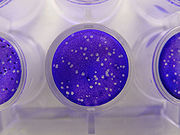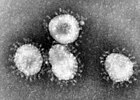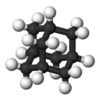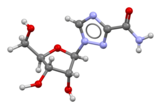Our website is made possible by displaying online advertisements to our visitors.
Please consider supporting us by disabling your ad blocker.
Portal:Viruses
The Viruses Portal
Welcome!
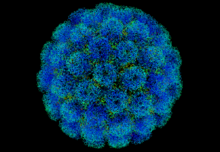
Viruses are small infectious agents that can replicate only inside the living cells of an organism. Viruses infect all forms of life, including animals, plants, fungi, bacteria and archaea. They are found in almost every ecosystem on Earth and are the most abundant type of biological entity, with millions of different types, although only about 6,000 viruses have been described in detail. Some viruses cause disease in humans, and others are responsible for economically important diseases of livestock and crops.
Virus particles (known as virions) consist of genetic material, which can be either DNA or RNA, wrapped in a protein coat called the capsid; some viruses also have an outer lipid envelope. The capsid can take simple helical or icosahedral forms, or more complex structures. The average virus is about 1/100 the size of the average bacterium, and most are too small to be seen directly with an optical microscope.
The origins of viruses are unclear: some may have evolved from plasmids, others from bacteria. Viruses are sometimes considered to be a life form, because they carry genetic material, reproduce and evolve through natural selection. However they lack key characteristics (such as cell structure) that are generally considered necessary to count as life. Because they possess some but not all such qualities, viruses have been described as "organisms at the edge of life".
Selected disease
Hepatitis C is an infectious disease affecting mainly the liver, caused by hepatitis C virus (HCV), an RNA virus of the Flaviviridae family which only infects humans and chimpanzees. A "non-A non-B hepatitis" was postulated in the 1970s, and HCV was demonstrated in 1989. HCV is spread primarily by blood-to-blood contact associated with intravenous drug use in the developed world, and with improperly sterilised medical equipment and blood transfusions in the developing world. In about 80% of those infected, the virus establishes a chronic infection in the liver, and around 10–30% of those infected will develop cirrhosis over 30 years. Some people with cirrhosis go on to develop liver failure, liver cancer or other serious complications.
An estimated 143 million people worldwide (2%) have chronic HCV infections as of 2015. The prevalence is highest in Central and East Asia, North Africa and the Middle East. The virus causes around a quarter of cases of cirrhosis and hepatocellular carcinoma, and is a major reason for liver transplantation. The recommended therapy is an appropriate combination of protease inhibitors. Although 95% of people treated in this way are cured, the treatments are expensive and older therapies are less effective. No vaccine against hepatitis C is available.
Selected image
An HIV protease inhibitor (white) bound to its target, the HIV-1 protease (blue and green). The viral enzyme is a dimer of two identical subunits with the active site (red) in the cleft between them.
Credit: Boghog (28 June 2008)
In the news
26 February: In the ongoing pandemic of severe acute respiratory syndrome coronavirus 2 (SARS-CoV-2), more than 110 million confirmed cases, including 2.5 million deaths, have been documented globally since the outbreak began in December 2019. WHO
18 February: Seven asymptomatic cases of avian influenza A subtype H5N8, the first documented H5N8 cases in humans, are reported in Astrakhan Oblast, Russia, after more than 100,0000 hens died on a poultry farm in December. WHO
14 February: Seven cases of Ebola virus disease are reported in Gouécké, south-east Guinea. WHO
7 February: A case of Ebola virus disease is detected in North Kivu Province of the Democratic Republic of the Congo. WHO
4 February: An outbreak of Rift Valley fever is ongoing in Kenya, with 32 human cases, including 11 deaths, since the outbreak started in November. WHO
21 November: The US Food and Drug Administration (FDA) gives emergency-use authorisation to casirivimab/imdevimab, a combination monoclonal antibody (mAb) therapy for non-hospitalised people twelve years and over with mild-to-moderate COVID-19, after granting emergency-use authorisation to the single mAb bamlanivimab earlier in the month. FDA 1, 2
18 November: The outbreak of Ebola virus disease in Équateur Province, Democratic Republic of the Congo, which started in June, has been declared over; a total of 130 cases were recorded, with 55 deaths. UN
Selected article
Virus quantification is necessary for viral vaccine production, and is used to manage people infected with HIV, hepatitis B and C, and cytomegalovirus. A wide range of traditional and modern methods are used. Plaque assays (pictured) infect a monolayer of host cells with dilutions of the virus and count the number of holes or plaques, where cells have lysed and infected their neighbours. For viruses that do not lyse their host cell, plaques of cells showing cytopathic effects can be counted or viral proteins can be immunostained with fluorescent-labelled antibodies. These methods quantify infectious virus, while others, such as electron microscopy, return a higher concentration because they count all virus particles, whether or not they are viable. Other assays, such as the haemagglutinin assay, quantify viral proteins.
Often slow and labour intensive, traditional methods have been complemented by modern technologies that greatly reduce quantification time, including quantitative polymerase chain reaction, flow cytometry, enzyme-linked immunosorbent assays and tunable resistive pulse sensing.
Selected outbreak
The 1993 hantavirus outbreak in the Four Corners region of southwest USA was of a novel hantavirus, subsequently named Sin Nombre virus. It caused the previously unrecognised hantavirus pulmonary syndrome – the first time that a hantavirus had been associated with respiratory symptoms. Mild flu-like symptoms were followed by the sudden onset of pulmonary oedema, which was fatal in half of those affected. A total of 24 cases were reported in April–May 1993, with many of those affected being from the Navajo Nation territory. Hantavirus infection of humans generally occurs by inhaling aerosolised urine and faeces of rodents, in this case the deer mouse (Peromyscus; pictured).
Previously documented hantavirus disease had been confined to Asia and Europe, and these were the first human cases to be recognised in the USA. Subsequent investigation revealed undiagnosed cases dating back to 1959, and Navajo people recalled similar outbreaks in 1918, 1933 and 1934.
Selected quotation
| “ | ...the variety of genes on the planet in viruses exceeds, or is likely to exceed, that in all of the rest of life combined. | ” |
Recommended articles
Viruses & Subviral agents: bat virome • elephant endotheliotropic herpesvirus • HIV • introduction to viruses![]() • Playa de Oro virus • poliovirus • prion • rotavirus
• Playa de Oro virus • poliovirus • prion • rotavirus![]() • virus
• virus![]()
Diseases: colony collapse disorder • common cold • croup • dengue fever![]() • gastroenteritis • Guillain–Barré syndrome • hepatitis B • hepatitis C • hepatitis E • herpes simplex • HIV/AIDS • influenza
• gastroenteritis • Guillain–Barré syndrome • hepatitis B • hepatitis C • hepatitis E • herpes simplex • HIV/AIDS • influenza![]() • meningitis
• meningitis![]() • myxomatosis • polio
• myxomatosis • polio![]() • pneumonia • shingles • smallpox
• pneumonia • shingles • smallpox
Epidemiology & Interventions: 2007 Bernard Matthews H5N1 outbreak • Coalition for Epidemic Preparedness Innovations • Disease X • 2009 flu pandemic • HIV/AIDS in Malawi • polio vaccine • Spanish flu • West African Ebola virus epidemic
Virus–Host interactions: antibody • host • immune system![]() • parasitism • RNA interference
• parasitism • RNA interference![]()
Methodology: metagenomics
Social & Media: And the Band Played On • Contagion • "Flu Season" • Frank's Cock![]() • Race Against Time: Searching for Hope in AIDS-Ravaged Africa
• Race Against Time: Searching for Hope in AIDS-Ravaged Africa![]() • social history of viruses
• social history of viruses![]() • "Steve Burdick" • "The Time Is Now" • "What Lies Below"
• "Steve Burdick" • "The Time Is Now" • "What Lies Below"
People: Brownie Mary • Macfarlane Burnet![]() • Bobbi Campbell • Aniru Conteh • people with hepatitis C
• Bobbi Campbell • Aniru Conteh • people with hepatitis C![]() • HIV-positive people
• HIV-positive people![]() • Bette Korber • Henrietta Lacks • Linda Laubenstein • Barbara McClintock
• Bette Korber • Henrietta Lacks • Linda Laubenstein • Barbara McClintock![]() • poliomyelitis survivors
• poliomyelitis survivors![]() • Joseph Sonnabend • Eli Todd • Ryan White
• Joseph Sonnabend • Eli Todd • Ryan White![]()
Selected virus
Coronaviruses are a subfamily of RNA viruses in the Nidovirales order which infect mammals and birds. They are spherical enveloped viruses, generally around 80–120 nm in diameter, containing a helical nucleocapsid. Their positive-sense single-stranded RNA genome ranges from approximately 26 to 32 kb in size, one of the largest among RNA viruses. Around 74 characteristic club-shaped spikes project from the envelope, which in electron micrographs resemble the solar corona, from which their name derives. Infectious bronchitis virus was isolated in 1933 from chickens; two mice coronaviruses causing hepatitis and encephalomyelitis were discovered in the 1940s.
Coronaviruses predominantly infect epithelial cells, with the viral spike protein determining tissue tropism and host range. Animal coronaviruses often infect the gastrointestinal tract, causing diarrhoea in cows and pigs, and are transmitted by the faecal–oral route. Human and bird coronaviruses infect the respiratory tract, are transmitted via aerosols and droplets; they cause respiratory tract infections that can range from mild to lethal. Mild illnesses in humans include around 15% of common cold cases, while more lethal coronaviruses cause SARS, MERS and COVID-19. Many human coronaviruses have evolved from viruses of bats.
Did you know?
- ...that derivatives of diamond-like compound adamantane (model pictured) are used as drugs against flu and Parkinson's disease?
- ...that for 36 years, only two polyomaviruses were known to infect humans?
- ...that Ali Maow Maalin was the last person in the world to be infected with naturally occurring smallpox?
- ...that in his 2005 book Race Against Time, the UN Special Envoy for HIV/AIDS in Africa Stephen Lewis claimed the spread of AIDS across Africa is partly due to a succession of disastrous economic policies promoted by international financial institutions?
- ...that his son's infection with polio in 1930 led electrical engineer Reinhold Rudenberg to develop an electron microscope as a tool to study the poliovirus?
Selected biography
Ali Maow Maalin (1954 – 22 July 2013) was a hospital cook and health worker from Merca, Somalia, who is the last person in the world known to be infected with naturally occurring smallpox. Although he worked in the local smallpox eradication programme, he had not been successfully vaccinated. In October 1977, he was infected with the Variola minor strain of the virus while driving two children with smallpox symptoms to quarantine. He did not experience complications and made a full recovery. An aggressive containment campaign was successful in preventing an outbreak, and smallpox was declared to have been eradicated globally by the World Health Organization (WHO) two years later.
In later life, Maalin volunteered for the successful poliomyelitis eradication campaign in Somalia. He worked for WHO as a local coordinator with responsibility for social mobilisation, and spent several years travelling across Somalia, vaccinating children and educating communities. He encouraged people to be vaccinated by sharing his experiences with smallpox. He died of malaria while carrying out polio vaccinations after the reintroduction of poliovirus to the country in 2013.
In this month
February 1939: First virology journal, Archiv für die gesamte Virusforschung, appeared
8 February 1951: Establishment of the HeLa cell line from a cervical carcinoma biopsy, the first immortal human cell line
12 February 1892: Dmitri Ivanovsky (pictured) demonstrated transmission of tobacco mosaic disease by extracts filtered through Chamberland filters; sometimes considered the beginning of virology
19 February 1966: Prion disease kuru shown to be transmissible
23 February 2018: Baloxavir marboxil, the first anti-influenza agent to target the cap-dependent endonuclease activity of the viral polymerase, approved in Japan
27 February 2005: H1N1 influenza strain resistant to oseltamivir reported in a human patient
24 February 1977: Phi X 174 sequenced by Fred Sanger and coworkers, the first virus and the first DNA genome to be sequenced
28 February 1998: Publication of Andrew Wakefield's Lancet paper, subsequently discredited, linking the MMR vaccine with autism, which started the MMR vaccine controversy
Selected intervention
Ribavirin is a nucleoside analogue that mimics the nucleoside guanosine. It shows some activity against a broad range of DNA and RNA viruses, but is less effective against dengue fever, yellow fever and other flaviviruses. The drug was first synthesised in the early 1970s by Joseph T. Witkowski and Roland K. Robins. Ribavirin's main current use is against hepatitis C, in combination with pegylated interferon, nucleotide analogues and protease inhibitors. It has been used in the past in an aerosol formulation against respiratory syncytial virus-related diseases in children. Ribavirin has been used in combination as part of an experimental treatment for rabies. It is also the only available treatment for the viruses causing some viral haemorrhagic fevers, including Lassa fever, Crimean–Congo haemorrhagic fever and hantavirus disease, but is ineffective against the filovirus diseases, Ebola and Marburg. Clinical use is limited by the drug building up in red blood cells to cause haemolytic anaemia.
Subcategories
Subcategories of virology:
Topics
Things to do
- Comment on what you like and dislike about this portal
- Join the Viruses WikiProject
- Tag articles on viruses and virology with the project banner by adding {{WikiProject Viruses}} to the talk page
- Assess unassessed articles against the project standards
- Create requested pages: red-linked viruses | red-linked virus genera
- Expand a virus stub into a full article, adding images, citations, references and taxoboxes, following the project guidelines
- Create a new article (or expand an old one 5-fold) and nominate it for the main page Did You Know? section
- Improve a B-class article and nominate it for Good Article
 or Featured Article
or Featured Article status
status - Suggest articles, pictures, interesting facts, events and news to be featured here on the portal
WikiProjects & Portals
 WikiProject Viruses
Related WikiProjects
WikiProject Viruses
Related WikiProjects
Medicine • Microbiology • Molecular & Cellular Biology • Veterinary Medicine
Related PortalsAssociated Wikimedia
The following Wikimedia Foundation sister projects provide more on this subject:
-
Commons
Free media repository -
Wikibooks
Free textbooks and manuals -
Wikidata
Free knowledge base -
Wikinews
Free-content news -
Wikiquote
Collection of quotations -
Wikisource
Free-content library -
Wikispecies
Directory of species -
Wikiversity
Free learning tools -
Wiktionary
Dictionary and thesaurus
Previous Page Next Page




